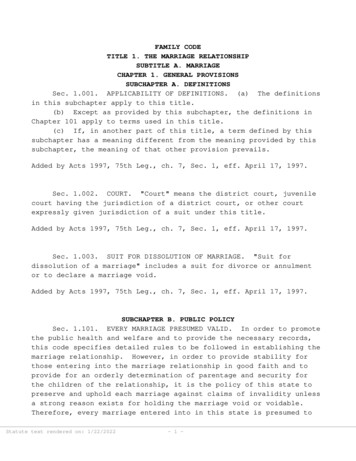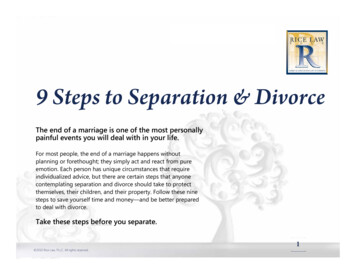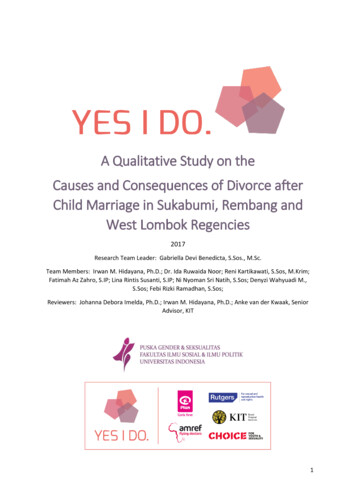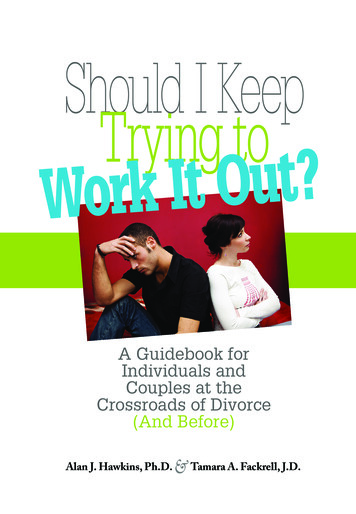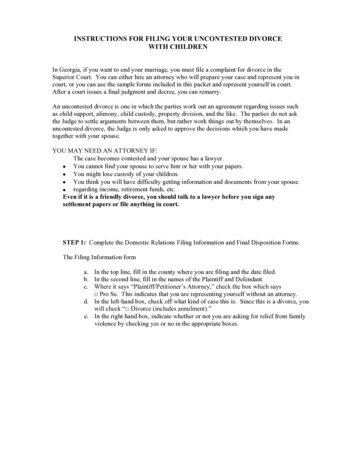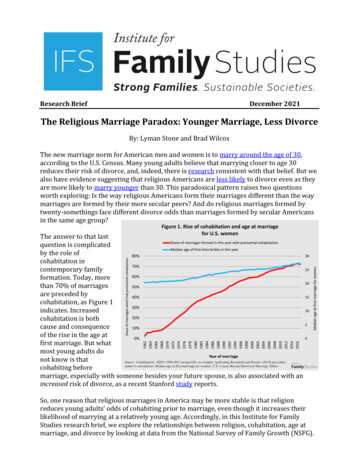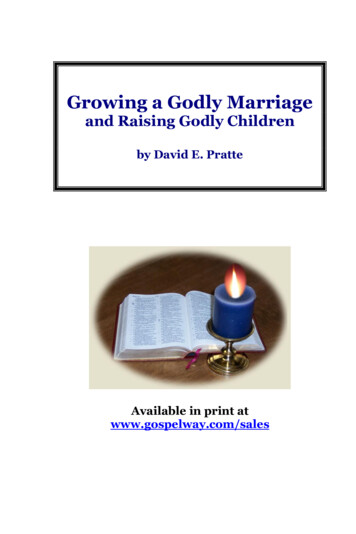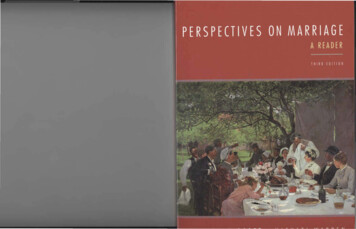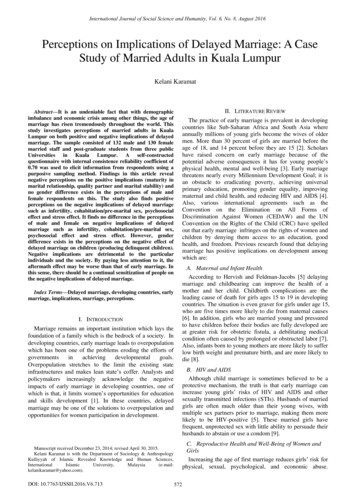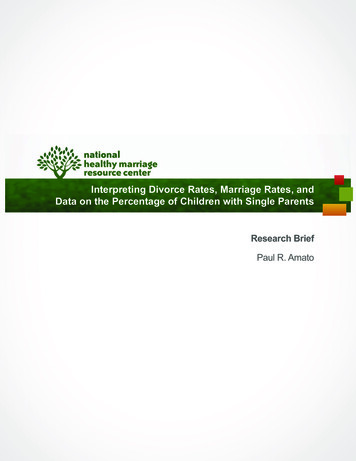
Transcription
Interpreting Divorce Rates, Marriage Rates, andData on the Percentage of Children with Single ParentsResearch BriefPaul R. Amato
Interpreting Divorce Rates, Marriage Rates, andData on the Percentage of Children with Single ParentsThe United States federal government releases data(which began in the 1940s), is a monthly survey ofon rates of marriage and divorce in most years, alongabout 50,000 households conducted by the U.S. Cen-with information on the percentage of children livingsus Bureau for the Department of Labor Bureau ofwith two parents and single parents. Stories basedLabor Statistics. The March supplement to this surveyon these statistics often appear in the media. Manycontains questions on marital status and other familypeople, however, are confused by these data—howcharacteristics. During the last decade, the Americanthese numbers should be interpreted and what theyCommunity Survey (ACS), which is conducted bymean for trends in family life. The goal of this Re-the U.S. Census Bureau, has become an especiallysearch Brief is to help people understand how theseimportant data source. Each year the ACS samplesvarious rates and statistics are calculated and shouldabout three million households in the United States.be interpreted.The recent addition of questions on marriage anddivorce makes the ACS one of the main sources ofData on family statistics come from two primaryinformation on current rates of marriage and divorce.sources: vital statistics and surveys. Total counts ofmarriages and divorces are reported by state andcounty offices to the federal government and aresummarized in publications from the Centers forDisease Control and Prevention National Center forHealth Statistics. Funding for the collection and publication of detailed marriage and divorce statistics wassuspended in January 1996 and, as a result, somestates no longer report this information. Consequently, surveys have become increasingly important to fillin the gaps from incomplete vital statistics data. Oneimportant data source, the Current Population SurveyData on family statistics come fromtwo primary sources: vital statisticsand surveys. Total counts of marriagesand divorces are reported by stateand county offices to the federalgovernment and are summarizedin publications from the Centers forDisease Control and PreventionNational Center for Health Statistics.Divorce RatesAs noted earlier, federal funding for the collection andpublication of detailed marriage and divorce statisticswas suspended in 1996. As a result, several states donot submit vital statistics on divorce on a regular basis. For example, in 2004, California, Georgia, Hawaii,Indiana, and Louisiana did not report this information.For this reason, there is no complete count of howmany divorces occur in the United States annually.Interpreting Divorce Rates, Marriage Rates, andData on the Percentage of Children with Single Parents2
Despite this limitation, the U.S. Census Bureau usesA better measure—the refined divorce rate—is thedata from participating states to calculate the crude di-number of divorces per 1,000 married women. Thisvorce rate, which is the number of divorces per 1,000rate is preferable to the crude divorce rate becausepeople in the population. This measure is less thanthe denominator includes only those people at risk ofoptimal because the denominator includes childrendivorce. The federal government has not published in-and single adults who are not at risk of divorce. More-formation on the refined divorce rate for many years.over, the crude divorce rate is affected by the ageNevertheless, in 2008 the annual ACS added a ques-structure of the population. (For example, changes intion on divorce (and marriage) during the previousthe proportion of children in the population will affectyear. The addition of this question (which will continuethe divorce rate, even if the underlying divorce trendin subsequent surveys) makes it possible to calculateis stable.) And, as noted earlier, the crude divorce ratea refined divorce rate for the United States, includingexcludes data from states (including large states suchstates that do not report information on divorce statis-as California) that do not report divorce data to thetics to the federal government. An analysis of this itemfederal government.indicates that the refined divorce rate ranged from alow of 14.3 in North Dakota to a high of 34.5 in Wash-The U.S. Census Bureau uses datafrom participating states to calculatethe crude divorce rate, which is thenumber of divorces per 1,000 peoplein the population. For this reason,the rate does not have a clearinterpretation. Moreover, the crudedivorce rate is affected by the agestructure of the population.ington, DC, with a national average of 19.4 (NationalCenter for Family and Marriage Research, 2010). Anadvantage of the refined divorce rate is that it has aclear interpretation. That is, dividing the rate by 10yields the percentage of marriages that end in divorceevery year. Currently, this figure is about 2%. A possible limitation of relying on the ACS is that surveys(in general) appear to underestimate the frequencyof divorce when compared with vital statistics (Martinand Bumpass, 1989). When the federal governmentreleases vital divorce statistics for 2008, it should beNevertheless, the crude divorce rate provides a roughpossible to assess the extent and importance ofindication of changes in divorce over time. For exam-any bias.ple, the rate rose from 2.2 in 1960 to 5.3 in 1981—a141% increase. The rate then dropped gradually to3.6 in 2007—a 32% decline (U.S. Census Bureau,2010, Table 78). A study by Heaton (2002) foundthat the rise in age at first marriage since the 1980sand, to a lesser extent, increased education appearto be responsible for this decline. An advantage ofthe crude divorce rate is that it can be compared withrates in other countries. For example, Eurostat publishes an annual yearbook that includes crude divorcerates for all European countries (Eurostat, 2009).A better measure—the refined divorcerate—is the number of divorces per1,000 married women. This rate ispreferable to the crude divorce ratebecause the denominator includesonly those people at risk of divorce.Nevertheless, in 2008 the annual ACSadded a question on divorce (andmarriage) during the previous year.Interpreting Divorce Rates, Marriage Rates, andData on the Percentage of Children with Single Parents3
Although the refined divorce rate is valuable, manyA refinement to the cohort method was introducedpeople want to know the percentage of marriagesby Schoen and Canudas-Romo (2006) who incorpo-that eventually end in divorce. To answer this ques-rated timing effects of divorce into their analysis. Theirtion, one must adopt a cohort approach. That is, theanalysis indicates that the probability of a marriagequestion can be answered only with respect to a spe-ending in divorce increased linearly throughout thecific marriage cohort (people who married in a given20th century and reached a plateau in the 1990s, withyear or set of adjacent years). People who marriedthe most recent estimate (for the year 2000) indicat-in 1990, for example, may have a different lifetimeing that 45% of marriages would end in divorce. If weprobability of divorce than people who married intake into account the fact that a small percentage of2000. Because the refined divorce rate is a periodmarriages end in permanent separation rather thanrate (based on the number of divorces in a particulardivorce, then the overall rate of union disruption isyear across different cohorts), it cannot answer thisslightly less than 50%. In other words, the commonlyquestion. Consider couples who married in 1970. Bycited statistic that about half of all marriages end inusing a cohort approach and collecting retrospec-disruption (divorce or permanent separation) appearstive marital history data in 2010, the percentage ofto be reasonably accurate.these unions that had ended in divorce within thefirst 40 years of marriage could be calculated. (AfterIt is important to note that these estimates are not40 years, the likelihood of divorce is small.) A limita-based on the ratio of divorces to marriages in a givention of the cohort approach arises when it is appliedyear—a common misconception. Currently there areto recent marriages. For example, for couples whoabout two marriages for every divorce. One cannotmarried in 1990, information is only available on theuse this information to calculate the probability of di-first 20 years of marriage. The problem of incompletevorce, however, because the population of individualsinformation becomes more challenging when evenwho marry in a given year differs from the populationmore recent marriages are considered.of individuals who divorce in a given year. Conse-To account for this limitation, projections about thepercentage of recent marriages that are likely to endin divorce must be made based on current trends.Demographers use life table methods to reflectoutcomes for a synthetic cohort of people whoexperience duration-specific divorce risks in a givenyear. That is, they examine the percentage of peoplemarried for one year who divorced in the previousyear, the percentage of people married for two yearsquently, the ratio of divorces to marriages provides noinformation about the eventual likelihood of dissolution for any marriage cohort.Marriage RatesComparable to the crude divorce rate, the crude marriage rate is the number of marriages in a given yearper 1,000 people in the population. The crude marriage rate in the United States rose from 8.5 in 1960who divorced in the previous year, and so on. Theseto a high of 10.6 in the early 1980s. Since then, thisduration-specific rates are combined through life tablerate has dropped to 7.3 in 2007—a 31% decline (U.S.methods to yield the cumulative proportion of couplesCensus Bureau, 2010, Table 78). Like the crudeprojected to divorce. These estimates show what thedivorce rate, the crude marriage rate has importantlikelihood of divorce would be if the duration-specificlimitations. First, because the denominator includesrates of divorce in a given year were to remain un-people who are not “at risk” of getting married (suchchanged into the future.as children and already married individuals), thisInterpreting Divorce Rates, Marriage Rates, andData on the Percentage of Children with Single Parents4
figure does not have a clear interpretation. Second,second limitation is that prior to 2007, the Census Bu-the crude marriage rate does not provide informa-reau defined a single parent as an unmarried parent,tion on the percentage of Americans who eventuallyirrespective of whether the parent was living with thewill marry. Using a cohort perspective (as describedother biological parent. In other words, a child livingearlier), demographers project that the percentagewith a biological mother and a biological father wasof adults who eventually will marry is close to 90%counted as living with a single parent if the child’s par-(Cherlin, 2009). This percentage represents a declineents were not married. Consequently, prior to 2007,from several decades ago, when the projected figureofficial reports of the percentage of children living withwas 95%. Nevertheless, this decline is not nearly asa “single parent” underestimated the percentage ofsteep as the decline suggested by the crude marriagechildren living with two biological parents. This wasrate. The rising age at first marriage accounts for thisa growing problem because most of the increase inapparent discrepancy. Because young adults arenonmarital births during the last couple of decadesdelaying marriage until older ages, the crude mar-has been due to the rise in the number of childrenriage rate has been declining. But because the greatborn to cohabiting but unmarried couples (Bumpassmajority of young adults eventually marry (albeit atand Lu, 2000).older ages), the overall level of marriage has declinedmuch less dramatically.The Percentage of Children Livingwith Single ParentsTo rectify the latter problem, the Census Bureauchanged its definitions in 2007, so that children living with two biological but unmarried parents werecounted as living in two-parent households. Due toEvery year the U.S. Census Bureau publishesthis redefinition, the percentage of children reportedinformation on the percentage of children living withto be living with two parents increased from 67% totwo parents, single mothers, single fathers, and71% between 2005 and 2007. More recent data,neither parent. For example in 2005, 67% of childrenwhich also includes information on stepparents,lived with two parents, 23% lived with single moth-provides a more complete picture of children’s livingers, 5% lived with single fathers, and 5% lived witharrangements. The 2009 Current Population Surveyneither parent (U.S. Census Bureau, 2010, table 69).(March) indicated that 69.8% of children lived with twoComparing these data with earlier years indicates thatparents, 62.5% of children lived with two biologicalthe percentage of children living with a single parentparents, and 59.7% lived with two married biologicalhas increased substantially since 1960. Most of thisparents (U.S. Census Bureau, 2009). Corresponding-information comes from the March supplement to thely, 26.2% of children lived with a single parent. In ad-Current Population Survey.dition to the Current Population Survey, the AmericanCommunity Survey will provide annual information onUntil recently, these data had two major limitations.The first limitation is that the “two parent” categorythis topic into the foreseeable future.included two biological (or adoptive) parents as wellConclusionas one biological parent living with a stepparent.The federal government and social scientists haveConsequently, the percentage of children living withgenerated a great deal of information on rates of mar-two parents is larger than the percentage of childrenriage, divorce, and single parenthood. Much of thisliving with two biological (or adoptive) parents. Theinformation, however, is difficult for the typical observ-Interpreting Divorce Rates, Marriage Rates, andData on the Percentage of Children with Single Parents5
er to interpret, and a good deal of confusion appearsto exist among the general public. Some of the majorReferencesBumpass, Larry, and Hsien-Hen Lu. (2000). Trends insources of confusion include:cohabitation and implications for children’s(1) It is unclear how divorce and marriage rates arefamily contexts in the United States. Populationcalculated and how they should be interpreted.(2) Confounding annual period rates (which reflectthe number of marriages and divorces in a particularyear) with cohort projections (which reflect the lifetimeStudies, 54, 29-41.Cherlin, Andrew. (2009). The Marriage-Go-Round: TheState of Marriage and the Family inAmerica Today. New York: Alfred A. Knopf.Eurostat. (2009). Europe in Figures: Eurostat Yearbookprobabilities of marriage and divorce for individuals2009. Luxembourg: Office for Officialborn in particular years) has led to the erroneous con-tions of the European Communities.clusion that the probabilities of marriage and divorcehave declined dramatically in recent decades.(3) Misinterpreting federal data on the percentage ofchildren living with two parents, which (until recently)counted stepfamilies as two-parent families and /ITY OFFPUB/KS-CD-09-001/EN/KS-CD-09-001-EN.PDF)Heaton, T. B. (2002). Factors contributing to increasingmarital stability in the United States.Journal of Family Issues, 23, 392-409.Martin, Teresa Castro and Larry L. Bumpass. (1989).habiting couples with biological children as single-par-Recent trends in marital disruption. Demography,ent families. This confusion has led to either over or26, 37-51.under estimates of the percentage of children residingwith two biological parents.The goal of this Research Brief has been to facilitate the interpretation of data on marriage, divorce,National Center for Family and Marriage Research.(2010). Divorce Rate in the U.S., 2008.(http://ncfmr.bgsu.edu/family %20marriage lit/Family%20Profiles/Divorce%20in%20US 2008.pdf)Schoen, R., Canudas-Romo, V. (2006). Timing effectson divorce: 20th century experience in theand single parenthood. Despite the fact that theUnited States. Journal of Marriage and Family, 68,federal government withdrew financial support for749-758.the compilation of vital statistics on marriage anddivorce several years ago, recent improvements tothe American Community Survey, combined with newinformation available from other federally funded national surveys, should make it possible to accuratelymonitor future trends in marriage, divorce, and singleU.S. Census Bureau (2009). Current Population Survey,2009 Annual Social and EconomicSupplement. am/cps2009.html)U.S. Census Bureau. (2010). Statistical Abstract of theUnited States: 2010 (129th Edition) Washington,DC. rpreting Divorce Rates, Marriage Rates, andData on the Percentage of Children with Single Parents6
probability of divorce than people who married in 2000. Because the refined divorce rate is a period rate (based on the number of divorces in a particular year across different cohorts), it cannot answer this question. Consider couples who married in 1970. By using a cohort approach and collecting retrospec-
